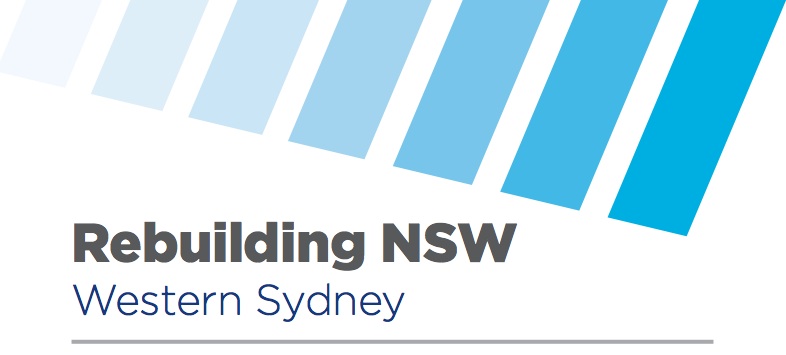In June 2014, the Government announced Rebuilding NSW – a new plan to turbocharge NSW. This will release $20 billion in capital from leasing the State’s electricity businesses for investment in new productive infrastructure - meaning critical projects can get moving now, rather than years into the future.

The NSW Government has reviewed the investment recommendations put forward by Infrastructure NSW, the Government’s expert investment body, and accepts these recommendations.
More than $10 billion for investment to benefit Western Sydney
With a population of over 2 million people, Western Sydney is now bigger than many of Australia’s capital cities. Rebuilding NSW
invests $10 billion in Western Sydney and presents a once-in-a-generation opportunity to build the infrastructure that Western Sydney desperately needs.
This includes:
- Sydney Rapid Transit - a $7 billion investment to increase the number of trains accessing the city by 60%
- Parramatta Light Rail - a $1 billion investment to transform Parramatta
- Western Harbour Tunnel - allowing up to 50,000 cars to bypass the CBD each day.
This will ensure Western Sydney not only keeps up with forecast population growth, but thrives, delivering the jobs and economic foundations to become an even better place to work and live.
Parramatta as Sydney’s second CBD
Parramatta is Sydney’s second CBD and it needs the transport connections to support continued growth. The Government has already reserved $400 million for a light rail network in Parramatta. The Government will commit a further $600 million for light rail, bringing the funding commitment to $1 billion.
Confirming Parramatta’s status as Sydney’s second CBD means investing in the cultural and sporting facilities the city deserves. The Government will create a Parramatta Cultural Precinct as a component of current urban renewal activities in the area. Parramatta has a range of cultural and heritage assets that could be better connected and utilised. To complement this, the Government will consider relocating the Powerhouse Museum collection to the new precinct.
A congestion busting plan
As the engine room of our State’s economy, the Government is committed to delivering improved transport infrastructure to the people of Western Sydney, especially for its major roads.
WestConnex will help bust the city’s congestion and better connecting western and south western Sydney with the Sydney CBD, port and airport.
The Government will build on the benefits of WestConnex by reserving $1.1 billion to invest in the northern and southern extensions and the new Western Harbour Tunnel.
In addition to delivering new motorways, the Government will use our existing roads more effectively. This includes reserving $400 million to implement Smart Motorways technologies,
including on the M4. Investments to address bottlenecks and pinch point upgrades will be targeted to improve traffic flows and reduce congestion in Western Sydney. Our city needs transformative projects like WestConnex, but it also needs these small upgrades to better manage our roads. We will deliver both.
Public transport links to the west
An efficient, reliable, accessible public transport system is critical to the prosperity and quality of life of any city. Rebuilding NSW provides us with the opportunity to extend the benefits of public transport to more communities across Western Sydney. Public transport connects people to jobs and improves the liveability of Western Sydney by providing access to key destinations.
The reliability and frequency of services on the existing passenger rail network will also be improved progressively under Sydney’s Rail Future Stage 2. The Government will reserve $1 billion to deliver this plan for the Western Sydney Rail Upgrade Program which specifically targets the capacity constraints on the T1 Western Line.
Construction of the North West Rail Link is well underway with services planned to commence in 2019. In addition, a $7 billion contribution reserved for Sydney Rapid Transit (SRT), together with funds already earmarked, ensures the project is fully funded, with a mid-range estimated cost of $10.4 billion. The proposed network will include new rapid services at stations in Bankstown,
Punchbowl, Wiley Park, Lakemba, Belmore, Campsie and Canterbury.
The benefits of the SRT will be wider still – it will unlock new rail capacity across the entire rail network. Western Sydney needs more trains, fewer delays and faster connections. We are delivering the upgrades to make this happen.
Better hospitals and schools in Western Sydney
In addition to the Government’s record investment in health and education, Rebuilding NSW presents an opportunity to build the new schools and hospitals Western Sydney needs to accommodate future population growth.
This will include a share of:
> the $700 million Future Focussed Schools Program to deliver new schools in Sydney’s growth areas.
> the $600 million Hospital Growth Program.
Business cases will be developed for hospital investments at places such as Rouse Hill and Campbelltown, as well as for new paediatric capacity in South Western Sydney.
The Government is also exploring innovative education models.
Upgraded stadia and cultural facilities
Western Sydney also needs an increase of investment in its arts and cultural infrastructure. Families in Western Sydney shouldn’t always have to travel into the Sydney CBD to participate in cultural and sporting activity.
The NSW Government will also engage with Western Sydney councils to identify coinvestment proposals for cultural infrastructure. Engagement will commence immediately.
Western Sydney will also benefit from the $600 million stadia fund. As part of that, the Government will identify the best investments for rectangular stadia at Parramatta/Sydney Olympic Park - investments that will provide world class sporting venues for Western Sydney.
The Government will also look at long term options for the construction of an outer Western Sydney stadium to support expected population growth.
Planning for future growth
In the long term, land will be reserved for future Western Sydney road corridors, which may include the Outer Sydney Orbital and the Bells Line of Road – Castlereagh Connection to the M7. This will ensure that we are able to deliver infrastructure efficiently and effectively when it is needed. This is part of our strategic long term planning approach to develop Western Sydney.